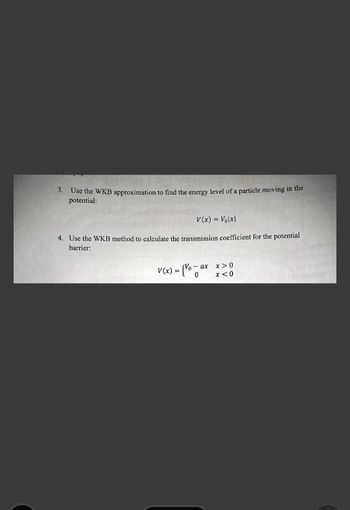Question
thumb_up100%

Transcribed Image Text:3. Use the WKB approximation to find the energy level of a particle moving in the
potential:
V(x) = Volx|
4. Use the WKB method to calculate the transmission coefficient for the potential
barrier:
V(x) = {Va
-ax x>0
0
x<0
Expert Solution
This question has been solved!
Explore an expertly crafted, step-by-step solution for a thorough understanding of key concepts.
This is a popular solution
Trending nowThis is a popular solution!
Step by stepSolved in 1 steps with 2 images

Knowledge Booster
Similar questions
- V (x) = 00, V(x) = 0, x<0,x 2 a 0arrow_forwardThe energy of a particle in a one-dimensional trap with zero potential energy in the interior and infinite potential energy at the walls is proportional to (n = quantum number):arrow_forwardWhich of the following is/are correct for the equation y(x) dx defined for a particle whose state function is y(x) (11) (iii) This equation gives the probability of the particle with the range x to X₂. This equation applies to the particle moving in any dimension. This equation defines relation between the state function and the probability with the range x; to x₂- (a) Only (1) (b) (ii) and (iii) (c) (i) and (iii) (d) (i) and (ii)arrow_forward
- QUESTION 6 Consider a 1-dimensional particle-in-a-box system. How long is the box in radians if the wave function is Y =sin(8x) ? 4 4л none are correct T/2 O O Oarrow_forwardThe electron moves in an infinitely deep. potential well with a width of l=0.15 nm. a) Calculate the minimum (i.e. ground state) speed of the electron. V₁=? b) Calculate the reaction force that the electron causes when it moves back and forth and collides with the other wall of the well adiabatically (thermally insulated). F=? c) Calculate the frequency of the electron's back and forth motion. f=?arrow_forward2. Consider a particle of mass m in an infinite square well, 0(≤ x ≤a). At the time t = 0 the particle is in the ground (n = 1). Then at t> 0 a weak time-dependent external potential is turned on: H' = Axe Tarrow_forward
arrow_back_ios
arrow_forward_ios